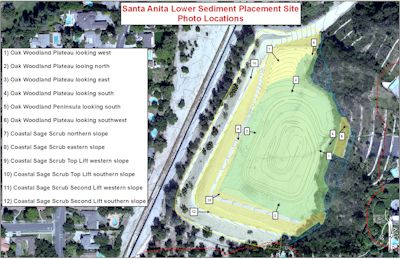



PROJECT SUMMARY
Santa Anita Habitat Mitigation Project Update March 2024
The Los Angeles County Flood Control District (District) continues work on the Santa Anita Habitat Mitigation Project (HMP), located at the Santa Anita Lower Sediment Placement Site (SPS) in Arcadia. The HMP was created as compensatory mitigation for impacts associated with the Santa Anita Dam Riser Modification and Sediment Removal Project which was completed in 2012.
The goal of the HMP is to create habitat (5.5 acres of oak woodland and 2.5 acres of coastal sage scrub) in an area that was previously without any vegetation and biodiversity. The HMP is a collaborative effort between the District and a team of experts in the fields of ecology, arboriculture, wildlife biology, habitat installation and maintenance (contractors), landscape architecture, native plant nurseries, and native seed collectors. Please refer to the photo locations map below for progress photos.
Maintenance and monitoring of the area began in January 1, 2015, and work will be completed over a minimum seven-year period, or until the site meets the performance criteria that were determined in coordination with the California Department of Fish and Wildlife.
Site Preparation, Installation, and Maintenance
Site preparation has included conditioning of the placed sediment by cultivating a large volume of locally-salvaged native mulch into the soil. Tons of natural boulders and woody debris from adjacent habitat areas were placed on the site - including multiple natural snags (upright, dead tree trunks) - to provide habitat value. More than 9,000 native plants and over 200 pounds of native seeds have been planted to date. All plants and seeds were collected within the local subwatershed to maintain genetic integrity; native oaks were primarily established from planted acorns. A temporary fence was installed to protect oak sprouts from excessive herbivory. Maintenance tasks include erosion control, weed management, supplemental seeds application, and stormwater management using eco-friendly materials and methods. The irrigation on the mitigation site was gradually reduced in the first few years of the maintenance period, then fully discontinued in 2018, to promote deep rooting and drought resiliency of the native trees, shrubs, and perennial plants.
Biodiversity: Plants and Wildlife
More than 150 species of native plants have been observed on the site, which was previously only compacted sediment, including oaks (coast live oak, Engelmann oak, and San Gabriel oak), cacti, ferns, shrubs, vines, annual/perennial wildflowers, and grasses. The growth and survival of the planted oaks is excellent with many of the saplings now exceeding 12-15 feet in height. The site also supports multiple species of beneficial fungi and non-vascular plants (e.g., moss) that are associated with the placed woody debris and other habitat features. A total of 115 native vertebrate wildlife species have been observed on the mitigation site, including treefrogs, lizards, snakes, songbirds, owls/raptors, chipmunks, bobcats, foxes and deer, A total of 15 native bird species have already nested on the site, including acorn woodpeckers that nest in cavities in the snags. A diversity of arthropods has also been observed on the site, including butterflies and other beneficial insects that contribute to the natural 'food web'.
Miscellaneous
The restoration specialist accesses the site via the Elkins Avenue gate. The District has instructed the restoration specialist not to operate heavy trucks or transport equipment through the residential streets before 7 a.m. or after 5 p.m., Mondays through Fridays. No maintenance work will be performed during the weekends.
NO TRESPASSING is permitted on the Lower SPS. Trespassing can damage native plants, disturb sensitive wildlife such as nesting birds, and introduce noxious weeds via seeds that are spread by shoes or pets' fur.
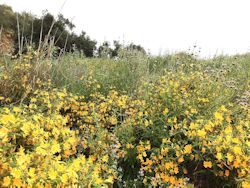
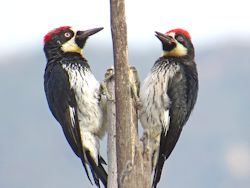
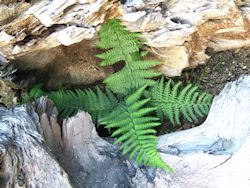
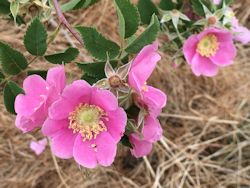
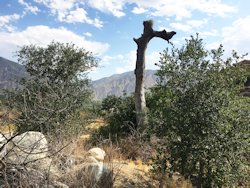
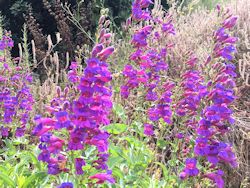
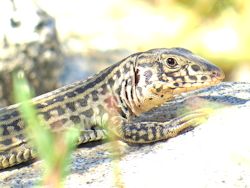
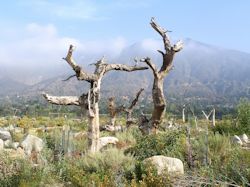
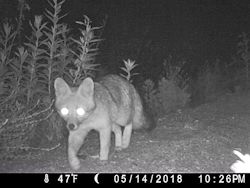
RESOURCES
- Southern California Academy of Sciences Presentation - May 4, 2024
- UC 8th Oak Symposium Presentation - November 1, 2022
- Seventh Annual Monitoring Report 2022
- Sixth Annual Monitoring Report 2021
- Fifth Annual Monitoring Report 2020
- Fourth Annual Monitoring Report 2019
- Third Annual Monitoring Report 2018
- Second Annual Monitoring Report 2017
- First Annual Monitoring Report 2016
- 2024-February Site Status Report
- 2021-December Site Status Report
- 2020-September Site Status Report
- 2019-December Site Status Report
- 2019-August Site Status Report
- 2018-December Site Status Report
- 2018-April Site Status Report
- 2017-January Site Status Report
- 2016-April Site Status Report
- 2015-October Site Status Report
- Community Presentation - June 19, 2013
- HMP Implementation Schedule
- Final Site Work Schedule
- Oak Woodland Habitat Revegetation/Mitigation Program (May 2014)
- Oak Woodland Habitat Revegetation/Mitigation Program (Revised Sept. 2016)
- Santa Anita Habitat Mitigation Brochure
CONTACTS
For more information on the project please contact Project Manager, Maria Lee at marlee@dpw.lacounty.gov
Updated on: 05/30/2024
